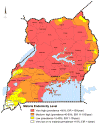Malaria in Uganda: challenges to control on the long road to elimination: I. Epidemiology and current control efforts
- PMID: 21420377
- PMCID: PMC3156969
- DOI: 10.1016/j.actatropica.2011.03.004
Malaria in Uganda: challenges to control on the long road to elimination: I. Epidemiology and current control efforts
Abstract
Malaria remains one of the leading health problems of the developing world, and Uganda bears a particularly large burden from the disease. Our understanding is limited by a lack of reliable data, but it is clear that the prevalence of malaria infection, incidence of disease, and mortality from severe malaria all remain very high. Uganda has made progress in implementing key malaria control measures, in particular distribution of insecticide-impregnated bednets, indoor residual spraying of insecticides, utilization of artemisinin-based combination therapy to treat uncomplicated malaria, and provision of intermittent preventive therapy for pregnant women. However, despite enthusiasm regarding the potential for the elimination of malaria in other areas, there is no convincing evidence that the burden of malaria has decreased in Uganda in recent years. Major challenges to malaria control in Uganda include very high malaria transmission intensity, inadequate health care resources, a weak health system, inadequate understanding of malaria epidemiology and the impact of control interventions, increasing resistance of parasites to drugs and of mosquitoes to insecticides, inappropriate case management, inadequate utilization of drugs to prevent malaria, and inadequate epidemic preparedness and response. Despite these challenges, prospects for the control of malaria have improved, and with attention to underlying challenges, progress toward the control of malaria in Uganda can be expected.
Copyright © 2011 Elsevier B.V. All rights reserved.
Figures




References
-
- Achan J, Byarugaba J, Barennes H, Tumwine JK. Rectal versus intravenous quinine for the treatment of childhood cerebral malaria in Kampala, Uganda: a randomized, double-blind clinical trial. Clin Infect Dis. 2007;45:1446–1452. - PubMed
-
- Arinaitwe E, Sandison TG, Wanzira H, Kakuru A, Homsy J, Kalamya J, Kamya MR, Vora N, Greenhouse B, Rosenthal PJ, Tappero J, Dorsey G. Artemether-lumefantrine versus dihydroartemisinin-piperaquine for falciparum malaria: a longitudinal, randomized trial in young Ugandan children. Clin Infect Dis. 2009;49:1629–1637. - PubMed
Publication types
MeSH terms
Substances
Grants and funding
LinkOut - more resources
Full Text Sources
Medical

